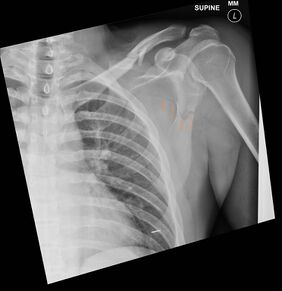Scapula fractures
Scapula fractures are usually caused by a direct mechanism (impact on the scapula from behind), or indirect side impact on the shoulder. They are often associated with fractures of the proximal humerus, lateral clavicle, or ribs.
Classification according to the affected part of the bone[edit | edit source]
Type I - fractures of the body of the scapula (stable, do not dislocate thanks to the surrounding muscles)
Type II - apophyseal fractures (stable) - coracoid proc., acromion
Type III - superior external angle fractures - neck (stable), glenoid fossa (unstable)
Clinical signs[edit | edit source]
- relief position in adduction;
- pain when moving the shoulder (especially abduction - rotation and elevation) and during palpation;
- sometimes significant subcutaneous hematoma.
Diagnostics[edit | edit source]
- X-ray – in anteroposterior and axial (transthoracic) projection, possibly tangential projection on the scapula;
- in the case of unclear CT (especially intra-articular fractures with damage to the labrum).
Therapy[edit | edit source]
- Conservative
- most fractures (including non-dislocated neck fractures);
- immobilization (Desault, Gilchrist for 2-4 weeks);
- then gradual mobilization of the arm in a sling;
- complete elevation of the limb after 6 weeks;
- for non-dislocated fractures of the acromion and the coracoid process is enough to rest on a scarf for 2 weeks.
- Operative
- displaced fractures of the neck, intra-articular fractures with impaired congruence of the glenoid fossa, fractures of the acromion with injury to the acromioclavicular joint;
- screws, splints.
Links[edit | edit source]
Source[edit | edit source]
- PASTOR, Jan. Langenbeck's medical web page [online]. [cit. 2010]. <http://langenbeck.webs.com>.

